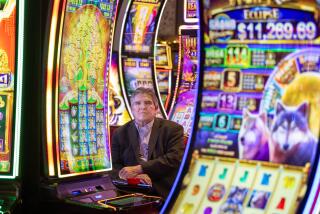Opponents Say Museum Would Destroy the Thing It Aims to Save
When it opens next year, the Agua Caliente Cultural Museum will encompass several acres of historic tribal land and put native Cahuilla culture on display.
To some tribal members, however, the 100,000-square-foot museum will stick out “like a sore thumb” on the landscape and put their culture “in a box.”
The museum, which will sit on an alluvial fan at the mouth of the lush palm oases of the Indian Canyons, will overlook the historic site of Rincon Village, the original settlement of the Cahuilla people. Some tribal members object to the museum’s planned proximity to their ancestral village.
“A lot of tribal members think the museum is going to break up the spirit that runs through the area,” said Tony Andreas, a tribal elder and former tribal historian. “It’s going to be obtrusive, it’s going to be a blight on the area, and our culture’s going to be put in a little box: the museum.”
Other tribal officials and museum administrators say the site adjoins -- but does not impinge on -- the remains of the village. Several surveys of the land have found no burial grounds and no archeological remains beneath the proposed facility’s grounds, said Michael Hammond, executive director of the museum, which is currently in a small building in downtown Palm Springs.
Tribal Chairman Richard Milanovich said that although he supports the museum location, he too questions its size and scale. His sons, in fact, voiced objections to the project early on. But its educational value will exceed its environmental impact, he said.
“I think it’s very important to construct a building to house our artifacts, and, more importantly, to have a place for people to go -- particularly our own tribal members -- to understand who the Cahuilla people are,” Milanovich said. “Because once you understand your own background, it’s so much easier for you to move forward.”
The museum is essential to educating tribal members and the general public about Cahuilla culture, officials said. Traditional ollas, or clay pots, and basketry will be on display. As an affiliate of the Smithsonian Institution, the museum will have access to troves of Native American artifacts. And space will be set aside for classes in the Cahuilla language, history and crafts, Hammond said.
“Usually, tribes pass their knowledge and wisdom down from elders to young people, and this museum will serve as that,” Hammond said. “It will be a place where young people of the tribe can go to learn about their culture, their heritage”
Some young tribal members say, however, that their true legacy rests on these brush-covered hillsides and valleys where their people lived for centuries. There, they say, the first Cahuilla settled before spreading out across the Coachella Valley.
And there, tribal song and legends recall, the people returned as birds after wandering the continent in grief following the death of their creator. They want that land to remain open space so their children also can return there someday.
“The younger people want to be able to show their kids where their people landed, where their heritage is, so they can keep showing it to different generations,” said Marina Elizondo, 15.
“It’s really all we have left when it comes to tribal lands,” said Desmond Saubel, 28. “It’s the only thing we can call sacred. Everything else is town. Everything else is developed. It’s all that’s basically untouched.”
Signs posted at the entrance to the Indian Canyons protest the plans.
“It is in our blood to protect this area and leave it intact just as my ancestors did for all of us,” the signs say.
To those who oppose the location, the plans pose a sad irony: For a decade, they fought to preserve the site and surrounding lands from development, only to see the tribe itself make plans to build the museum there.
In the early 1980s, private developers proposed the Andreas Cove Country Club, an area of luxury homes surrounding an 18-hole golf course, on tribal allotments around the new museum site. With the help of local residents who formed Friends of Indian Canyons, the tribe secured grants to buy back the land in 1993.
A master plan for the area had included a smaller interpretive center set close to the road, said Gary Gray, chairman of the organization.
“When they came up with this plan [for a museum] and put it way up on the alluvial plain, we were all kind of shocked,” Gray said. “That area is on the National Register of Historic [Places], and has been for decades. So they’re trying to put the museum on what most people had assumed would be open space.”
After Andreas called him for help, the group commissioned a report on the museum, which concluded that it was simply too big. The building, he said, would disrupt the surrounding area of stark hills and stone ruins.
“When you can see the real thing, why go into a museum?” Gray said. “Why not leave the sacred resource alone?”
Gray, Andreas and others say they don’t object to the museum itself, and would welcome the facility elsewhere -- in downtown Palm Springs, perhaps.
But Hammond said those tribal members who complain now were silent during the two-year planning process for the museum and failed to speak out at several meetings the tribal government held on the project.
In fact, he said, some tribal members rejected a downtown site during those meetings, “because they didn’t want their tribe’s culture associated with Starbucks and T-shirt shops.”
More to Read
Start your day right
Sign up for Essential California for news, features and recommendations from the L.A. Times and beyond in your inbox six days a week.
You may occasionally receive promotional content from the Los Angeles Times.






